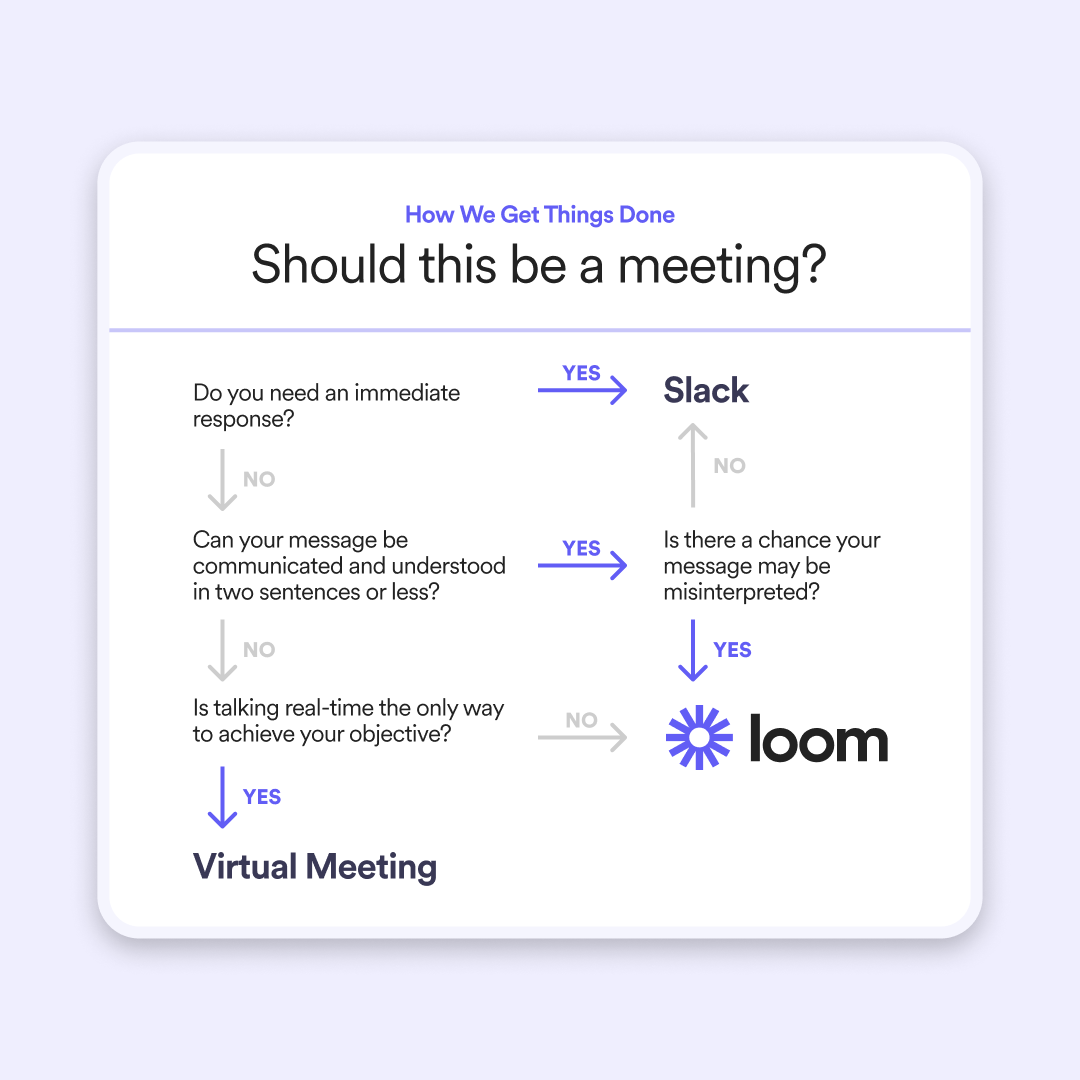The last few years have brought massive changes to the work world. Even before the pandemic, companies were starting to turn towards more flexibility, more remote and hybrid work, and more… meetings.
Prior to the pandemic’s acceleration of overwhelming meeting culture, 71% of managers said meetings were “costly and unproductive.” And since the onset of the pandemic, that number is somewhere around 92% -- recent studies even show that up to 70% of meetings actually distract employees from productive work.
So why do companies keep defaulting to live meetings when employees aren’t finding them valuable or productive?
At Loom, we use async communication heavily, and have guidelines (see below) in place to encourage teammates to be discerning about when a live meeting is necessary. However, we were finding ourselves also falling into the trap of defaulting to live meetings. It was clear that our guidelines weren’t enough.

Our solution? We implemented company-wide No-Meeting Days. Here’s how we did it, what we learned, and what we’d do differently.
What is a no meeting day?
First, let’s define what a No-Meeting day is:
Obviously, at the simplest level, it’s a day without live (aka synchronous) meetings! But there are different degrees of what a meeting-free day means for different teams. Here are a few examples of how they can take shape at an organization:
Blanket meeting ban: The most extreme version of a No-Meeting Day is when an organization institutes a ban and any and all live meetings for a full work day. No daily standups, “quick syncs,” or catch ups.
External meetings only: When an organization sets one day aside each week for no internal, live meetings, but allows for only critical external meetings with customers, partners, candidates, etc.
No recurring meetings: This lightweight No-Meeting Day approach simply bans any recurring meetings or weekly check-ins on this day, setting aside more time for deep work and focus time as well as timely meetings about current projects and priorities.
Department- or project-level: A specific team or department removes meetings for one day a week to make progress on a particular project.
Why did we decide to implement a meeting-free day?
We decided to implement a No-Meeting Day for three primary reasons:
Employee feedback
Market insights and data on productivity
Align with company values
Employee Feedback
Our primary reason to instate No Meeting Days was in response to direct feedback from our employees and team. In our 2021 Employee Engagement Surveys, one of the recurring takeaways was that team members felt it was often difficult to prioritize work effectively, make room for deep work, and stay on top of projects. There are many things that impact this, but one of them was a lack of focus time. (Even at Loom, where we often work largely asynchronously, we couldn’t escape the plague of constant and unproductive meetings!)
We also found that challenges were different depending on role. Many team leads and above were plagued with near-constant meeting requests. And ICs or more junior team members didn’t always feel empowered to suggest replacing or reducing meetings on their calendars.
Market Data and Insights
The second reason we implemented a No-Meeting Day was based on market data and industry research. In a survey Loom conducted of 3,000 office workers, workers reported wasting an average of one hour and 42 minutes per week scheduling and rescheduling calls – costing businesses in the U.S. $1.85 billion dollars weekly.
In addition to draining precious resources and time, an overload of meetings impacts employee experience. MIT Sloan released a survey report, The Surprising Impact of Meeting-Free Days, which found that too many meetings “negatively affects psychological, physical, and mental well being.” MIT’s study also gave us inspiration around the potential positive impact, finding that a 40% reduction in meetings increased productivity by 71% “because employees felt more empowered and autonomous.”
With clear data pointing to the uptick in team productivity and mental well-being of employees with meeting-free days, we knew prioritizing this effort would reap benefits across the company.
Align with company values
The third reason we implemented a No-Meeting Day was to align with our company and employer values. Here is an excerpt from an internal briefing developed when we were creating the case for No-Meeting Days:
Our employee promise is to “change the way you work.”
Ignoring any indications of burnout (ex: inability to complete work within normal hours or prioritize projects) could be detrimental to morale, satisfaction, and engagement long-term.
Loommates are asking for balance and the ability to carve out meaningful focus time to create balance within their work days, not to work less.
Not prioritizing balance within the workday is antithetical to our company mission and product vision.
If our team is stuck in constant sync meetings, it weakens our thought leadership position externally when it comes to the power of async meetings.
Prioritizing experimentation and radical changes to traditional work practices supports our continued ability to lead the modern work movement by example.
How we implemented a no meeting day
One of our goals for implementing a No-Meeting Day at Loom was to approach it as an experiment. We had done our research and oriented around our values, but that didn’t mean this experiment should be a unilateral, sudden decision org-wide. Instead, we tested different days of the week for a month at a time, and ran internal surveys to solicit employee feedback along the way. After a full quarter of experimentation and measurement, we instated No-Meeting Wednesdays for the foreseeable future.
Here’s a peek at our survey results from 120 respondents (a roughly 60% response rate for our team at the time):
97% of Loommates participated completely or partially in the experiment
85% said they want to make a No-Meeting Day a permanent practice
75% of Loommates said the experiment was a value-add to their week
53% said they want to keep it on Fridays, and 26% wanted to try Wednesday
An important reminder, however, is that everyone works differently and what is best for one person, role, or team, isn’t best for everyone. There were a few detractors of No-Meeting Days, and we solicited their valid feedback, which included the fact that meeting-free days caused more back-to-backs on other days of the week, and that it hindered progress on some timely projects.
That’s why an important ingredient with any organization-wide change is flexibility and room for autonomy. If all participants in a live meeting decide it’s absolutely necessary to hold it on a Wednesday, they can do so, but it should be the exception to the norm. We treat meeting-free days as a way to give every person—regardless of seniority—the autonomy to decline, reschedule, or replace internal meetings on that day in favor of deep work and focus time. That freedom is there every day of the week, but by setting aside a specific day for it, it creates more of a social expectation and opening to make those decisions. Today, not everyone utilizes No-Meeting Wednesday to the same extent. But for those who do find it valuable, they have the space to carve out a full day of focus time, boost their productivity, and bring balance within their workday.
Finally, a crucial piece of No-Meeting Wednesdays at Loom is… Loom! We leverage async video via the Loom platform heavily, and we saw an increase in usage on No-Meeting days. As compared to the previous quarter, the average number of Looms recorded on No-Meeting days increased by 63% and the average number of Looms viewed increased by 67%. While this change was also partly due to seasonality and team growth, our anecdotal survey responses backed up this trend. As one director-level Loommate shared, “It felt like I got faster and overall more engagement on the looms I sent internally [on No-Meeting Days].”
Tips for implementing your no meeting day
We’ve shared a deep dive into how our No-Meeting Day came to life at Loom. We’re still learning and iterating, but here’s a distillation of some of the best practices we’ve gathered throughout the process:
Identify the pain point first, then the solution
What isn’t working for your team? Is a No-Meeting Day the most urgent solution or do you need to look elsewhere to solve complex problems first?
Center company values all along the way
When you begin to design the rules of your No-Meeting day and the scope, start by revisiting your employer values first. Ensure you’re making decisions in line with those goals.
Prioritize employee feedback
This should be an integral part, every step of the way. Build simple surveys, gather anecdotal feedback, and make it an expectation that there will be regular readouts on the learnings.
Experiment: test, measure, iterate
Treat this like the experiment that it is in terms of testing a few different options. Identify how you will measure success, and include that in your reporting on employee feedback.
Utilize async
Empower your team to use async tools like Loom and Notion on No-Meeting Days to power collaboration without sync time.
Provide clarity and guidance
Make sure it’s extremely clear how employees should participate, and address common questions/pitfalls up front. Make sure you have buy-in from senior leadership, who can work with team leads to give guidance in smaller settings and provide self-serve access to a source of truth (ex: Notion doc).
Allow for flexibility and autonomy
Within those guidelines, make appropriate space for variations in the way that people work. Acknowledge those times when people can and should deviate.
Stay open
Keep measuring and listening. Workplaces and teams evolve naturally over time, as do their needs. What works one quarter might not work the next.
Conclusion
Synchronous meetings will always have a place in the workday, but if we’ve learned anything about remote work, it’s that they shouldn’t be the default. No-Meeting Days can be a powerful tool (and reprieve) for fast-paced teams, and lead to better meetings (whenever they need to happen). For most roles, the ideal workday balance looks like large blocks of focused time, fueled by async communication and collaboration, with a small number of stacked, strategic meetings. The result often looks like improved morale, motivation, and engagement — as well as meaningful productivity and efficiency gains.
Change management is tough, especially when it comes to default behaviors we’re all used to — included slapping that “quick sync” on the calendar. But once we start to question our defaults and build new processes? That’s where the magic can happen.

